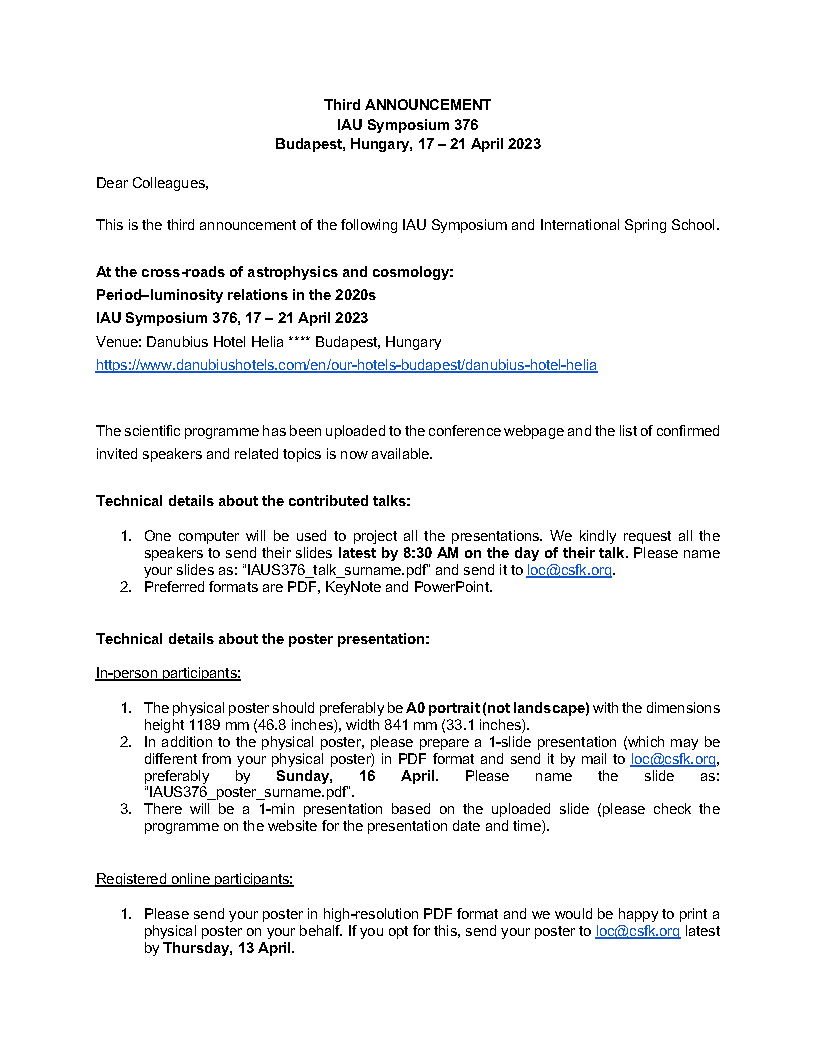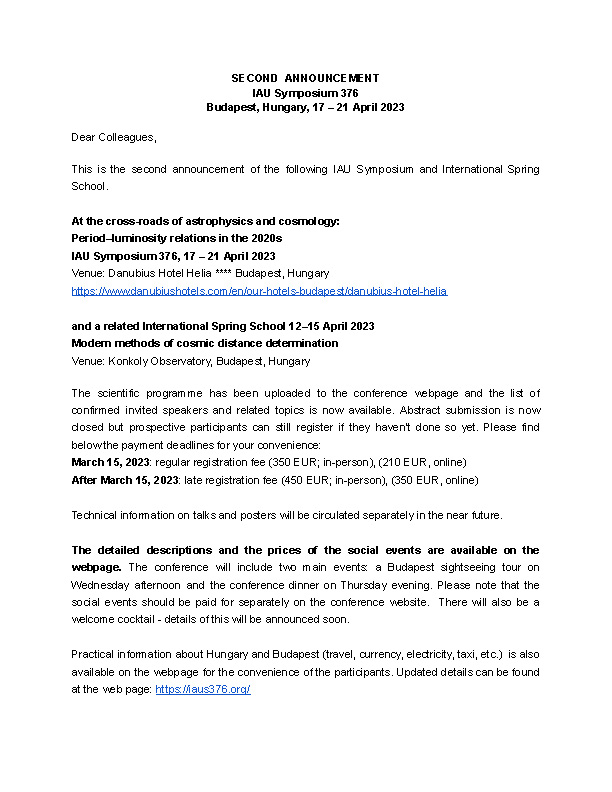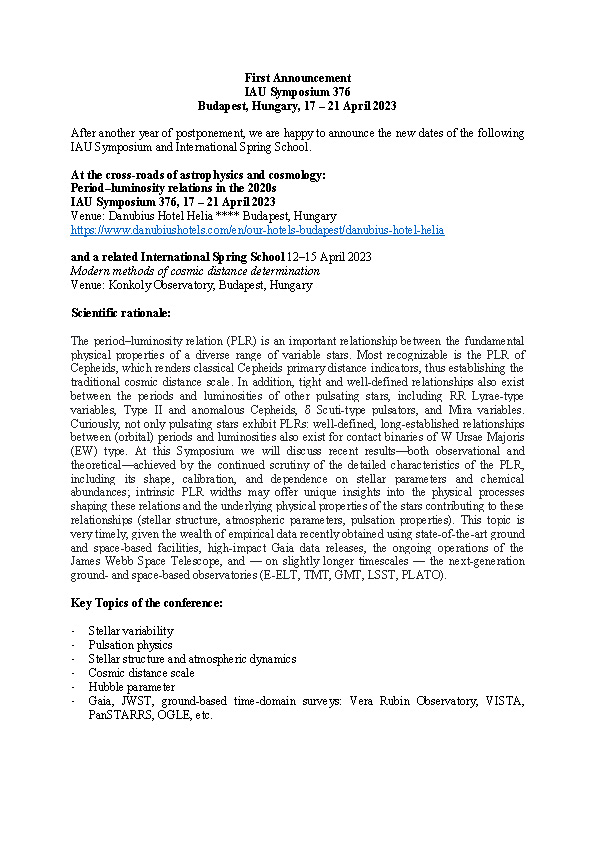
IAU Symposium 376 | 17-21 April 2023
At the cross-roads of astrophysics and cosmology: Period–luminosity relations in the 2020s
An event sponsored by IAU | hybrid conference in Budapest, Hungary
Programme
Download preliminary program in pdf format
Welcome reception
Sunday, 16 April
19:00-21:00
Sunday, 16 April 2023 |
|||
| 15:00–19:00 Registration | |||
| 19:00–21:00 | |||
| Welcome cocktail Hotel Danubius Helia – conference venue | |||
Monday, 17 April 2023 |
||||
| 09:00–12:20 Chair: Róbert Szabó | ||||
| 09:00–09:30 | Opening ceremony | Addresses by the SOC and LOC | ||
| 09:30–10:00 | R | Wendy Freedman (remote) | The Extragalactic Cepheid Distance Scale | |
| Session I: Setting the Scene – The Extragalactic ‘Problem’ | ||||
| 10:00–10:30 | R | Adam Riess | Local Value of the Hubble Constant from SH0ES | |
| 10:30–11:00 | Coffee/tea break | |||
| 11:00–11:30 | I | Rachael Beaton | H0 at its Foundation: The Limitations of Anchors of the Distance Scale | |
| 11:30–11:50 | C | Louise Breuval | The Cepheid Distance Scale and its Metallicity Dependence | |
| 11:50–12:20 | I | Myung Gyoon Lee | The Tip of the Red Giant Branch as a Cosmological Probe | |
| 12:20–13:30 | Lunch | |||
| 13:30–15:30 Chair: Richard de Grijs | ||||
| 13:30–13:50 | C | Gergely Dálya | Tackling the Hubble Tension with Gravitational Waves | |
| 13:50–14:10 | C | Richard I. Anderson | A 1% Calibration of Long-period Variable Stars for the Extragalactic Distance Scale | |
| 14:10–14:30 | C | Pierre Kervella | Inspecting the Ladder: the Cepheid Distance to the SN Ia Host Galaxy NGC 5584 | |
| 14:30–15:00 | R | Igor Soszyński | Period–Luminosity Relations in the Local Group of Galaxies | |
| 15:00–15:30 | P | Poster sparkler pitches [schedule TBD; chaired by session chair] | ||
| 15:30–16:00 | Coffee/tea break | |||
| 16:00–18:00 Chair: László Kiss | ||||
| Session II: Stellar Pulsation Physics | ||||
| 16:00–16:20 | C | Arief Ahmad | Self-excited Pulsations in Global 3D Simulations of Cool, Luminous and Evolved Stars | |
| 16:20–16:40 | C | Giulia De Somma | New Theoretical Period–Luminosity–Colour and Period–Wesenheit Relations for Anomalous Cepheids | |
| 16:40–17:00 | C | Richard de Grijs | New Double Mode Cepheids from the Zwicky Transient Facility Survey | |
| 17:00–17:20 | C | Saniya Khan | Investigating Gaia (E)DR3 Parallax Systematics Using Asteroseismology of Cool Giant Stars Observed by Kepler, K2, and TESS | |
| 17:20–17:40 | C | Gergely Hajdu | Circumstellar Matter Around RR Lyrae Variables | |
| 17:40–18:00 | C | Ernst Paunzen (remote) | Pulsation of Chemically Peculiar Stars | |
Tuesday, 18 April 2023 |
||||
| 09:00–10:30 Chair: Nancy Evans | ||||
| 09:00–09:20 | C | Mami Deka | A Study of Stellar Photosphere – Hydrogen Ionization Front Interaction in δ Scuti Stars | |
| 09:20–09:40 | C | Susmita Das | A Multiwavelength Analysis of BL Her Stars: Models versus Observations | |
| 09:40–10:00 | C | Géza Csörnyei | How ‘Accurate’ is ‘Precise’? The Effect of Period Fluctuations on PL Relations | |
| Session III: Primary Period–Luminosity Relation Calibrators in the Milky Way | ||||
| 10:00–10:30 | R | Gisella Clementini | Impact of the ESA Gaia Mission on the Primary Period – Luminosity Relation Calibrators in the Milky Way: Cepheids and RR Lyrae | |
| 10:30–11:00 | Coffee/tea break | |||
| 11:00–12:30 Chair: Tatiana Muraveva | ||||
| 11:00–11:30 | R | Martin Groenewegen | Primary Period–Luminosity Relation Calibrators in the Milky Way: Cepheids and RR Lyrae – Physical basis, Calibration, and Applications | |
| 11:30–11:50 | C | Bogumił Pilecki | Cepheids with Giant Companions – A New Abundant Source of Cepheid Astrophysics | |
| 11:50–12:10 | C | Mauricio Cruz Reyes | A Calibration of the Galactic Cepheid Luminosity Scale based on Gaia DR3 Open Cluster Astrometry | |
| 12:10–12:30 | C | Erasmo Trentin | Cepheid Metallicity in the Leavitt Law (C-MetaLL) Survey. The Metallicity Dependence of Cepheid Period–Luminosity Relations | |
| 12:30–13:40 | Lunch | |||
| 13:40–15:30 Chair: Caroline Huang | ||||
| 13:40–14:10 | I | Tatiana Muraveva | RR Lyrae Stars as Distance Indicators in the Gaia Era | |
| 14:10–14:30 | C | Laurent Eyer | Exploring the Complexities of Determining Mean Luminosity in Variable Stars: The Impact of Biased Means in Weighted Procedures | |
| 14:30–14:50 | C | Giuliana Fiorentino | RRLs to Trace Early Galaxy Formation | |
| 14:50–15:10 | C | Bartłomiej Zgirski | Near-Infrared Period–Luminosity Relations for Galactic RR Lyrae based on Photometry from OCA and Gaia DR3 Parallaxes | |
| 15:10–15:30 | C | Ilaria Musella | The Cepheid Based Cosmic Distance Scale: New Constraints from Updated Synthetic Multi-filter Cepheid PL Relations | |
| 15:30–16:00 | Coffee/tea break | |||
| 16:00–18:00 Chair: Martin Groenewegen | ||||
| 16:00–16:30 | I | Abdelmajid Benhida | Photometric and Spectroscopic Measurement Campaign on the RR Lyr (RR Lyrae) and R Scuti (RV Tauri), at the Oukaimeden Observatory in Morocco | |
| 16:30–16:50 | C | Weronika Narloch | Period–Luminosity Relations for Galactic Classical Cepheids in the Sloan bands | |
| 16:50–17:10 | C | Vincenzo Ripepi | On the Origin of Galactic Anomalous Cepheids | |
| 17:10–18:00 | Panel discussion Chair: László Kiss - New stellar observations and tools | |||
Wednesday, 19 April 2023 |
|||
| 09:00–12:30Chair: Gisella Clementini | |||
| Session IV: Disentangling the Structural Components of the Milky Way | |||
| 09:00–09:30 | R | Vasiliy Belokurov (remote) | Milky Way components with RR Lyrae |
| 09:30–10:00 | I | Akiharu Nakagawa | Stars and their Astronomical Applications |
| 10:00–10:30 | I | Dorota Skowron | The Structure of the Milky Way from Period–Luminosity Relations |
| 10:30–11:00 | Coffee/tea break | ||
| 11:00–11:20 | C | Fran Jiménez-Esteban | Variability Properties of the Gaia DR3 Catalogue of Galactic AGB stars |
| 11:20–11:40 | C | Yi Ren (remote) | Granulation in Red Supergiants: The Scaling Relations |
| 11:40–12:20 | P | Poster sparkler pitches [schedule TBD; chaired by session chair] | |
| 12:20–13:40 | Lunch | ||
| 14:00–17:00 | Budapest sightseeing | ||
| 18:30–20:30 | R | Adam Riess |
Public talk at the Hungarian Academy of Sciences The Surprising Expansion History of the Universe |
Thursday, 20 April 2023 |
|||
| 09:00–10:40 Chair: Vincenzo Ripepi | |||
| 09:00–09:20 | C | Matteo Monelli | Towards Homogeneous Distances in the Local Group |
| 09:20–09:40 | C | Teresa Sicignano | The Distance Scales of Anomalous and Type 2 Cepheids from Near Infrared Observations in the Magellanic Clouds |
| 09:40–10:00 | C | Mónica Taormina | Early-type Eclipsing Binaries as Distance Indicators |
| 10:00–10:20 | C | Alexandre Gallenne | Sub-percent Binary Star Masses and Distances from Interferometric Observations |
| 10:20–10:40 | C | Maria Tantalo | On the Use of the Mean J-band Magnitude of Carbon Stars as a Distance Indicator |
| 10:40–11:10 | Coffee/tea break | ||
| 11:10–12:20 Chair: Dorota Skowron | |||
| 11:10–11:40 | I | Armando Arellano Ferro (remote) | RR Lyrae Light Curves and their Role in the Globular Cluster Metallicity and Distance Determination |
| 11:40–12:00 | C | Javier Minniti | Using Classical Cepheids to Study the Far Side of the Milky Way Disk |
| 12:00–12:20 | C | Antonio Garcia Hernandez | The PL Diagram for dSct: Back in Business as Distance Estimators |
| 12:20–13:30 |
GROUP PHOTO Lunch |
||
| 13:30–15:30 Chair: Biwei Jiang | |||
| 13:30–14:00 | R | Marcella Marconi (remote) | Theoretical Stellar Pulsation Physics |
| Session V: Period–Luminosity Relations in the Nearby Universe | |||
| 14:00–14:30 | I | Anupam Bhardwaj | Period–Luminosity–Metallicity Relations for Classical Pulsators at Near-Infrared Wavelengths |
| 14:30–14:50 | C | Zoi Spetisieri | First Direct Measurement of the Stellar Association Bias in the SN Host Galaxy M101 |
| 14:50–15:10 | C | Kayla Owens | An Independent Analysis of the Multi-Wavelength Cepheid PL Relations in NGC 7250 |
| 15:10–15:30 | C | Kerdaris Kurbah | A Multi-phase Study of Theoretical and Observed Light Curves of Classical Cepheids in the Magellanic Clouds |
| 15:30–16:00 | Coffee/tea break | ||
| 16:00–18:00 Chair: Rachael Beaton | |||
| 16:00–16:20 | C | Vincent Hocdé | Metallicity Estimations of MW, SMC, and LMC Classical Cepheids from the Shape of the V- and I-band Light Curves |
| 16:20–16:40 | C | Shu Wang | Double-Mode RR Lyrae Stars – A Robust Distance and Metallicity Indicator |
| 16:40–17:00 | C | Felipe Espinoza-Arancibia | Empirical Constraints for the Instability Strip from the Analysis of LMC Cepheids |
| 17:00–18:00 | Panel discussion Chair: Patricia Whitelock: The Role of Machine Learning and its Applications | ||
Friday, 21 April 2023 |
|||
| 09:00–10:40 Chair: Patricia Whitelock | |||
| Session VI: Non-Traditional Period–Luminosity Relations | |||
| 09:00–09:30 | I | Biwei Jiang | The Period–Luminosity Relation of Red Supergiants |
| 09:30–10:00 | I | Michał Pawlak (remote) | Period–Luminosity Relations Formed by Contact and Close Binary Systems |
| 10:00–10:20 | C | Patryk Iwanek (remote) | Comprehensive Analysis of Mira-type Stars Variability and the Structure of the Milky Way |
| 10:20–10:40 | C | Miora Andriantsaralaza | Distance Estimates for AGB Stars – Gaia DR3 Parallax and PL Relation |
| 10:40–11:10 | Coffee break | ||
| 11:10–12:40 Chair: Anupam Bhardwaj | |||
| 11:10–11:30 | C | Clara Martinez-Vazquez | Breaking the Law: A Segmented Period - Luminosity Relation in delta Scuti Stars |
| 11:30–12:00 | I | Michele Trabucchi (remote) | Long-Period Variables as Distance and Age Indicators in the Era of Gaia and LSST |
| 12:00–12:20 | C | Caroline Huang | The Mira Distance to M101 |
| 12:20–12:40 | C | Piotr Wielgórski | Near-Infrared Period–Luminosity Relations for Type II and Anomalous Cepheids in the Solar Neighbourhood |
| 12:40–14:00 | Lunch | ||
| 14:00–15:30 Chair: Shu Wang | |||
| 14:00–14:30 | I | Xiaodian Chen | Possible Studies on Variable Stars based on CSST |
| 14:30–14:50 | C | Dieter Engels | OH/IR Stars and the Period–Luminosity–Relation of Mira Variables |
| 14:50–15:10 | C | Fangzhou Ren | An Uncharted but Valuable Distance Indicator: Period–Luminosity Relation of W UrsaeMajoris-type Contact Binaries |
| 15:10–15:30 | C | Megan Lewis | Galactic Center Miras: Period–luminosity Relations and Circumstellar Effects |
| 15:30– | Summary and closing ceremony | ||
Poster Session 1: Monday 17 April 2023, 15:00–15:30 |
||
| No. | Presenting author Poster title | |
| P1 | Christine Clement Helen Sawyer Hogg and the Globular Cluster Period–Luminosity Relation | |
| P2 | Zsófia Bora Distance Measurements of Type Ia Supernovae from Light Curve Fitting | |
| P3 | Anton Afanasiev Decreasing the scatter of SN Ia host Cepheid PL relations | |
| P4 | Chul Chung Population Age Origin of the Host Mass Step in Type Ia Supernovae | |
| P5 | Seunghyun Park Evidence for strong progenitor age bias in type Ia supernova distance scale: Lessons from Cepheids | |
| P7 | Steve Ardern First Detection of CO Emission from Cepheid Variables: a Step to Reducing the H0 Error Budget | |
| P8 | John Baruch A proposal for the absorption of light by dark matter to explain the Hubble Tension | |
| P9 | John Baruch Is the Period–Luminosity Relation for Cepheids upset by a small threshold for the absorption of light by Dark Matter? | |
| P10 | Géza Csörnyei Cepheids in M51: cross-checking the PLR distance with independent estimates | |
| P11 | Maria Tantalo Variable stars in NGC 6822 | |
| P12 | Mahtab Gholami Variable Stars in an Irregular Dwarf Galaxy, IC10 | |
| P13 | Hedieh Abdollahi Detection of Long-Period Variable Stars in And IX to Study Star Formation History and Dust Production Rate | |
| P15 | Jesper Storm The effect of metallicity on the PL relation from a Baade–Wesselink type analysis of a Cepheids in the Milky Way and the Magellanic Clouds | |
| P16 | Tahere Parto The Star Formation History and Chemical Enrichment of Sagittarius Dwarf Irregular Galaxy Derived from Long-period Variable Stars | |
| P18 | Gustavo Medina Toledo RR Lyrae Stars as Standard Candles and Tools to Disentangle the Milky Way’s History | |
| P19 | Bastian Lengen On the Consistency of the Cepheid and TRGB Distance Scales | |
| P20 | Zehao Zhang Dependence of Pulsation Mode of Cepheids on Metallicity | |
| P21 | Henryka Netzel Non-Radial Modes in Classical Pulsators — Perspectives for Asteroseismology | |
| P22 | Emese Plachy Classifying Milky Way Cepheids with TESS | |
| P23 | Dóra Tarczay-Nehéz Testing Ultra-low Amplitude Cepheid Candidates in the Galactic Disk by TESS and Gaia | |
| p24 | Gábor Kovács Thousand faces of convection | |
| P25 | Pradip Karmakar Types of Period Changes of Type II Cepheids | |
Poster Session 2: Wednesday 19 April 2023, 12:00–12:30 |
||
| No. | Presenting author Poster title | |
| P26 | József M. Benkő How Accurate are those Periods? | |
| P27 | Giordano Viviani VELOcities of Cepheids (VELOCE) DR1: An Unprecedented View of Cepheid RV Variability and Spectroscopic Binarity | |
| P28 | Young-Beom Jeon Review of BOAO Short Period Variable Star Surveys to Calibrate Period–Luminosity Relations | |
| P29 | Giovanni Catanzaro Metallicity determination from IGRINS spectra for a sample of Galactic Cepheids | |
| P30 | Nancy Evans The Mass of the Cepheid S Mus | |
| P31 | Javier Minniti Spectral Energy Distribution Fitting to Find and Characterize Cepheids in Binary Systems | |
| P32 | Garance Bras Observational Calibration of the Projection Factor of RR Lyrae Stars Using the SPIPS Pulsation Modeling | |
| P33 | Manuel Sánchez-Benavente Multiband Photometry and Spectroscopy of RR Lyrae Field Stars | |
| P34 | Vázsony Varga Improving the Gaia RR Lyrae Photometric Metallicities | |
| P35 | Cecilia Mateu Calibrating RR Lyrae Absolute Magnitudes as a Function of Period Shift to Correct Post-ZAHB Evolution Systematics | |
| P36 | Olivera Latković WUMaCat — The Largest Catalog of Individually Studied W UMa Stars | |
| P38 | Eric Hintz IR Spectroscopy of stars in various instability strips | |
| P39 | Adrienn Forró Validation of the RR Lyrae Identifications in the PanSTARRS PS1 3π Survey with K2 and Gaia | |
| P40 | Csilla Kalup Combined Gaia and K2 Studies of Globular Cluster Variables | |
| P41 | Ernst Paunzen Catalogue of Variable Stars in Open Cluster Fields | |
| P42 | Monika I. Jurkovic The Classification Intricacy of Different Types of Cepheid Variable Stars and the Case of RU Camelopardalis | |
| P43 | Mahdi Abdollahi Hierarchical Classification of Variable Stars Using Deep Convolutional Neural Networks | |
| P45 | Marcella Di Criscienzo Light Curve Recovery with the Rubin Observatory’s LSST | |
| P46 | Vittorio Francesco Braga Light curve templates of RR Lyrae in the LSST photometric system | |
| P47 | Jae Woo Lee The Post-Mass Transfer Eclipsing Binary WASP 1814+48: Absolute Properties and Multiperiodic Pulsations | |
| P48 | Justyna Olszewska Spectroscopic Analysis of the Variable Star CO Aurigae with the GATS Telescope | |
| P49 | Tahereh Ramezani Non-Variable Stars | |




